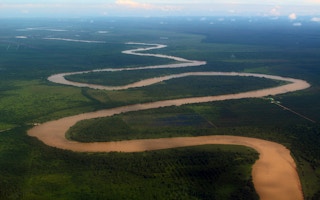How is the pandemic related to biodiversity?
Besides the cost in human life, the SARS-CoV-2 pandemic will cost the global economy around $28 trillion, according to the International Monetary Fund. This must be set against the cost of preventing further pandemics.
The World Health Organisation’s February report said that the most likely cause of the pandemic was a jump from animals to humans, specifically bats, even though the precise route may never be known.
“All the work that has been done on the virus and trying to identify its origin continue to point towards a natural reservoir of this virus and similar viruses in bat population,” it says.
There is a strong relationship between the loss of natural ecosystems and the risk of pandemics, described in the recently published reports on pandemics and the Global Assessment Report on Biodiversity and Ecosystem Services from the Intergovernmental Science-Policy Platform on Biodiversity and Ecosystem Services (IPBES) (a high level independent intergovernmental body often described as doing for nature what the Intergovernmental Panel on Climate Change does for climate).
The main report identifies over a million species at risk of extinction, not to mention the threats to the life-support functions of ecosystems — clean water and air, flood control and climate regulation, food, medicines and much more.
It puts mining alongside timber extraction, settlements and agricultural expansion as leading to deforestation and forest degradation, and driving new contact among people, animals and their microbes.
The IPBES report calls for a better understanding of the links between the risk of disease emergence and consumption patterns in developed and developing countries driving demand for meat, products of mining and expansion of agriculture.
This improved awareness would help better target consumption to protecting natural resources and reducing this risk.
About five new infectious diseases in people are identified every year, and 70 per cent of emerging diseases are caused by microbes of animal origin, says the IPBES.
The Nipah virus, for example, jumped from bats to pigs to people in 1998, and is attributed to the intensification of pig farming and deforestation in Malaysia. There is still no vaccine for Nipah, which kills up to 75 per cent of people it infects.
Human encroachment is changing the composition of ecosystems. “It’s this idea of how habitat degradation is leading to sick landscapes,” says David Redding at the Zoological Society of London.
He describes sick landscapes as disturbed landscapes that have replaced natural forest.
“They have both a higher proportion of disease-carrying species and greater numbers of them too.”
The price of development
Supporting the growing needs of up to 7.5 billion humans is having an exponential negative effect on the natural world.
The weight of man-made materials such as steel, plastic, and concrete is now greater than the weight of animals, plants, and microorganisms, according to Israel’s Weizmann Institute of Science. Roads, buildings, structures, and other objects have, over the twentieth century, doubled in mass every 20 years.
These demands on nature have caused an average 60 per cent loss in populations of vertebrates over the last fifty years, according to the WWF’s Living Planet Index.
This is “a grim reminder and perhaps the ultimate indicator of the pressure we exert on the planet,” comments Marco Lambertini, the director general of WWF International. “There cannot be a healthy, happy and prosperous future for people on a planet with a destabilised climate, depleted oceans and rivers, degraded land and empty forests.”
What can be done?
The logic would indicate that undisturbed ecosystems should be allowed to remain, and be increased in size. The proportion of the earth’s surface used to support humans should therefore be limited.
There have been powerful calls, led by E.O.Wilson, for this proportion to be one half. Organisations such as Nature Needs Half are campaigning for the protection of 50 per cent of the planet by 2030.
The figure of 40 per cent has been suggested by other researchers, if actioned alongside other key actions needed to reduce and reverse biodiversity loss caused by land use change.
These are outlined in a study published in Nature that used modelling to identify an ambitious, integrated strategy that combined conservation action and changes to food systems with wider efforts:
- Sustainable increases in crop yields
- Trade increases in agricultural goods with reduced trade barriers
- Reducing the waste of agricultural goods from field to fork by 50 per cent
- Cutting the share of animal calories in human diets by 50 per cent
- Increasing Protected Area extent to 40 per cent terrestrial coverage, covering important sites for biodiversity and with improved management
- Increasing restoration (reaching about 8 per cent of terrestrial areas by 2050) and landscape-level conservation planning that balances production and conservation objectives on all managed land
Combining these approaches could halt biodiversity loss by 2050, after which recovery begins, avoiding around two thirds of future terrestrial biodiversity losses caused by land use change, as explained in this graph:

Neil Burgess, chief scientist, UN Environment Programme World Conservation Monitoring Centre (UNEP-WCMC), and a contributing author of the study, said: “This research sets out clear and ambitious actions for governments, businesses, and consumers to take on board as we work together to tackle the global nature crisis.”
The next meeting of the Convention on Biological Diversity later this year is expected to discuss the findings and agree a post-2020 global biodiversity framework.
This would be a set of new international goals and targets for the next decade that embrace a sustainable and resilient recovery from the COVID-19 pandemic.
Alongside climate change, this is the main global challenge facing each one of us. We can all ask ourselves what we can do to protect and restore new and existing natural ecosystems.
This story was published with permission from The Fifth Estate.










